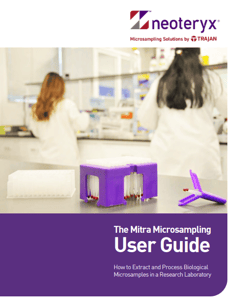microsampling to monitor environmental exposures
Researchers can utilize blood microsampling to track individuals' exposure to harmful chemicals and metals in the workplace or community. Even after certain toxic substances have been banned, finger-stick blood sampling has identified persistent toxins in the human body, including metals like lead or mercury and "forever chemicals" like PFAS or PFOS.
Microsampling for Human Health
Using just a few drops of blood from a finger stick, labs can analyze microsamples to measure an individual's exposure to environmental contaminants, ranging from metals to pesticides and other hazardous substances. Microsampling devices like Mitra® or hemaPEN® help streamline the process, offering a convenient and mobile solution for environmental health initiatives.
Frequently Asked Questions (FAQs)
Microsampling technologies like the Mitra® device or hemaPEN® can be used to collect finger-stick blood samples for lab analysis to detect heavy metals, chemicals and other environmental pollutants that may show up in the blood after exposure. Microsamples are easy to collect remotely & mail to the lab for testing, making them a potential medium for validated biomonitoring testing.
Many analytes can be extracted using our volumetric microsampling technologies, such as the hemaPEN® and Mitra® devices with VAMS®. These technologies have been demonstrated to be compatible with testing schema in published studies. Some of the literature and resources on our website discuss the different analytes that have been extracted using our microsampling devices. Visit our Technical Resource Library and type your analyte of interest in the library's search field to find relevant literature and case examples.
Sample success rates are high for Mitra® and hemaPEN® devices, which are based on volumetric microsampling. The absorptive VAMS® tips on Mitra can absorb homogenous samples with 99% acceptance rates.* By following the illustrated instructions and demo videos available with hemaPEN and Mitra, end-users can reliably collect fixed volume samples that are precise enough for lab analysis.
These volumetric microsampling devices overcome the hematocrit (HCT) bias that may occur with DBS cards, where non-homogenous blood spots on filter paper have higher variability and higher failure rates.*
*Data on sample success rates are discussed in published research articles in our online Microsampling Resource Library.
Example: https://www.medrxiv.org/content/10.1101/2021.01.27.21250570v1.full
Dried blood sampling continues to expand as laboratories adapt their testing techniques and technological advances allow for greater sensitivity and specificity. Published research papers show that dried capillary whole blood microsamples collected in 10, 20, or 30 µL volumes are enough for good extraction and analysis. These samples also yield high-quality data that are often similar to data from venous blood. The literature provides case examples of microsampling in research applications. Visit the Technical Resource Library to review many comparative studies that describe what others have achieved with microsampling in their research.
The process of transitioning to microsampling are divided into three steps or phases, with ongoing technical support from the Neoteryx Microsampling Team:
- Education: The introductory phase
- Evaluation: Extraction, linearity & signal-to-noise studies
- Validation: Validating your method
See our Microsampling User Guide for details.
 Microsampling User Guide
Microsampling User Guide
This technical user guide is designed to get you started with microsampling. The printed guidance from our technical director helps you make initial decisions on best practices for achieving solid analytical validations in your research projects. What microsample volume is needed for your assay? What analyte classes are compatible with microsampling? How do you process microsamples in the lab? Download the guide to find answers to these questions, and more!
Biomonitoring Blog Listing
Our microsampling devices have been used by several organizations running environmental health programs, so we cover this topic in our content. Click the button below to explore our blogs on biomonitoring for environmental toxins, health & wellness – all gathered together in a single, curated list.
2. Tech Blog: Using VAMS Microsampling for Mercury Biomonitoring
This blog from our Microsampling Technical Director, summarizes a published paper on an assay developed in Germany to measure mercury (Hg) levels from dried blood samples collected on Mitra® devices with VAMS® technology. Researchers saw a strong correlation between VAMS samples and venous samples. Click the button below to read the blog!
Gain Access to the Microsampling Resource Library!
How do others use microsampling to monitor exposures to environmental pollutants? For answers, fill out the form to gain access to our Microsampling Resource Library, where you can find materials by selecting either the resource type, key topic, assay or by typing your topic of interest in the general search field.


